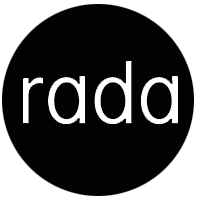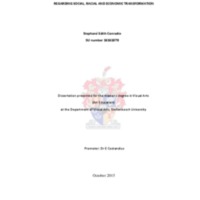Introducing a diploma course at the Department of Visual Arts at Stellenbosch University: An investigation into the attitudes and perceptions regarding social racial and economic transformation
Title
Introducing a diploma course at the Department of Visual Arts at Stellenbosch University: An investigation into the attitudes and perceptions regarding social racial and economic transformation
Subject
Dissertation presented for a Master Degree in Visual Arts (Art Education)
Description
1. Description of research for MA in Visual Arts (Art Education) thesis:
Introducing a diploma course at the Department of Visual Arts at Stellenbosch University: An investigation into attitudes and perceptions regarding social, racial and economic transformation
The Department of Visual Arts at Stellenbosch University (SU) was in the process of re-evaluating its current degree offerings in 2014 to see how it could include students from diverse racial, cultural and economic backgrounds. At the time there was a discussion about possibly creating a diploma course to form an extended degree programme that would give students whose portfolio met the requirements but whose matric marks did not meet the requirements for acceptance in to the BA in Visual Arts course the opportunity to use the diploma course to better their chances of entering into the degree programme after they had successfully completed the bridging course. The research I undertook for my MA in Visual Arts (Art Education) thesis aimed to create a platform on which such possibilities might be discussed and analysed. In this study it was important to see how transformation was linked to educational development and how this fed into concepts regarding social justice. From these theoretical concepts the investigation into the attitudes and perceptions of lecturers regarding a potential diploma course become valuable for understanding whether this education environment was ready for such a change to take place. Contextualising SU’s Department of Visual Arts with regard to how it is historically positioned as well as its efforts to transform gives a backdrop to how this research can potentially become a navigating tool for educational development in this department and further afield. The findings from this study highlighted a need for those involved in the development and implementation of a potential diploma course to be aware of their own position in this academic setting. The department also partakes in community engagement projects, where active steps can be taken to see how the department can use these projects to bridge academic gaps between secondary and tertiary education by actively seeking new ways in which the learners they work with can become feeder students. Identifying the importance of re-evaluating the curriculum to shift the focus from a Euro-American viewpoint to content that orientates itself to concentrate on more of a South African and African visual culture becomes central. To prevent further exclusion in this learning environment, support from older students in the form of mentorship may be helpful as well as hiring lecturing staff that portray a diverse lecturing staff body with which a multiracial student body can identify. Educational development can serve to liberate the effects that the past has had on people in the present. To move forward, a deep introspection of all the key role players in this kind of educational development must take place. A potential undergraduate diploma in the Department of Visual Arts may serve as a necessary platform for social justice by providing access to this knowledge area to students from a wider social, racial and economic standing.
Introducing a diploma course at the Department of Visual Arts at Stellenbosch University: An investigation into attitudes and perceptions regarding social, racial and economic transformation
The Department of Visual Arts at Stellenbosch University (SU) was in the process of re-evaluating its current degree offerings in 2014 to see how it could include students from diverse racial, cultural and economic backgrounds. At the time there was a discussion about possibly creating a diploma course to form an extended degree programme that would give students whose portfolio met the requirements but whose matric marks did not meet the requirements for acceptance in to the BA in Visual Arts course the opportunity to use the diploma course to better their chances of entering into the degree programme after they had successfully completed the bridging course. The research I undertook for my MA in Visual Arts (Art Education) thesis aimed to create a platform on which such possibilities might be discussed and analysed. In this study it was important to see how transformation was linked to educational development and how this fed into concepts regarding social justice. From these theoretical concepts the investigation into the attitudes and perceptions of lecturers regarding a potential diploma course become valuable for understanding whether this education environment was ready for such a change to take place. Contextualising SU’s Department of Visual Arts with regard to how it is historically positioned as well as its efforts to transform gives a backdrop to how this research can potentially become a navigating tool for educational development in this department and further afield. The findings from this study highlighted a need for those involved in the development and implementation of a potential diploma course to be aware of their own position in this academic setting. The department also partakes in community engagement projects, where active steps can be taken to see how the department can use these projects to bridge academic gaps between secondary and tertiary education by actively seeking new ways in which the learners they work with can become feeder students. Identifying the importance of re-evaluating the curriculum to shift the focus from a Euro-American viewpoint to content that orientates itself to concentrate on more of a South African and African visual culture becomes central. To prevent further exclusion in this learning environment, support from older students in the form of mentorship may be helpful as well as hiring lecturing staff that portray a diverse lecturing staff body with which a multiracial student body can identify. Educational development can serve to liberate the effects that the past has had on people in the present. To move forward, a deep introspection of all the key role players in this kind of educational development must take place. A potential undergraduate diploma in the Department of Visual Arts may serve as a necessary platform for social justice by providing access to this knowledge area to students from a wider social, racial and economic standing.
Creator
Stephane Conradie
Collection
Citation
Stephane Conradie, “Introducing a diploma course at the Department of Visual Arts at Stellenbosch University: An investigation into the attitudes and perceptions regarding social racial and economic transformation,” RADA , accessed May 30, 2025, https://collections.sun.ac.za/rada/items/show/309.
Document Viewer
Viewing: S.E. Conradie_Thesis (2).pdf
Geolocation













Leaflet | © OpenStreetMap contributors

